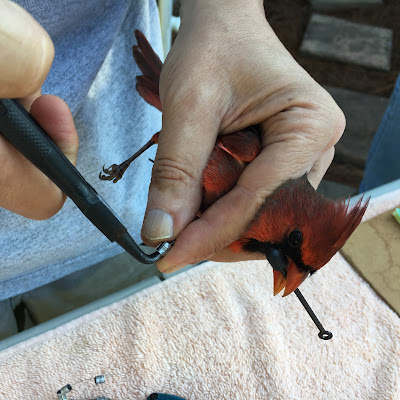However you celebrate let us wish you the best. Find out what makes your heart sing and do it. We are ever so grateful for family and friends and all who make my heart sing by being able to do this research. I appreciate the volunteers and the hosts who are contributing to our expanding knowledge of Painted Buntings and the other birds we band while doing this project.
The last four sessions of 2016 are done. We will now celebrate arriving family. We will be tallying birds since the fall Possum Long Banding through the end of the year. Keep in touch for details (totals at the bottom of the page). Painted Bunting banding will continue in the New Year and Possum Long banding will resume as we see more birds returning.
On December 12, we banded at PB 48. This is home of the bird that ended up in Cuba! We banded six more Painted Buntings. One was a green bird with red highlights. We had been told this is a trait of older females. Well, surprise, this bird was born last summer. The colors are NOT this bird molting into male colors. That doesn't happen until the fall of next year. It does not even mean it might be male - we just don't know. Likely it had lost a few feathers for some other reason entirely and they grew in more red and one was actually blue (on the belly!).
Painted Bunting
Another bunting we captured had lost its tail and it was regrowing. It looked so different with a short tail. You can see some of the sheaths that cover the new feathers.
Painted Bunting regrowing a lost tail
On December 14, we went to our first new location of the season. PB 65 had buntings and quite a few warblers. We banded some of each - 3 buntings and 10 incidentals: A Black-throated Blue Warbler, an American Redstart, an Ovenbird, an Orange-crowned Warbler, a Blue-gray Gnatcatcher, a Northern Cardinal, a Northern Mockingbird, a Blue Jay, a Red-bellied Woodpecker, and a Mourning Dove. We saw other warblers as well. If there were this many warblers still at Possum Long I think we'd be banding there.
The Blue Jay had had an injury to its bill. Possibly caught in some kind of snap-trap. The Red-bellied Woodpecker was quite red on the belly which is very hard to see when they are clinging to a trunk of a tree.
Blue Jay with old bill injury
Black-throated Blue Warbler
Red-bellied Woodpecker
On December 16, we returned to PB 32. In addition to two more Painted Buntings we were glad to catch five American Goldfinches. We also banded five Northern Cardinals. Surprisingly, one was still showing signs of being young (most young cardinals born last summer have completely molted now and have all adult plumage).
American Goldfinch - non-breeding male
Northern Cardinal
Today, December 18, we banded at PB 10 where we have not visited since Season 1. We were glad to return even though not many Painted Buntings were at the feeders (yet). We will likely revisit in the spring. The buntings have plenty of places to go once they see the nets and go to eat elsewhere. We banded two buntings, three Yellow-rumped Warblers, and a Mourning Dove.
Mourning Dove
green Painted Bunting - born last summer so cannot tell if it is male or female
(Not all of the labels would fit so some are abbreviated.)


















































